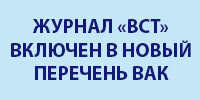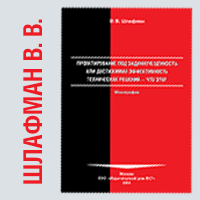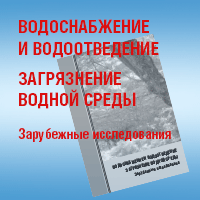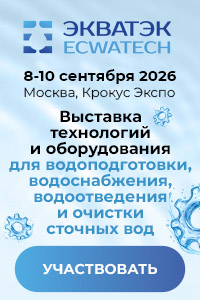№6|2020
DRINKING WATER SUPPLY
DOI 10.35776/MNP.2020.06.01
UDC 628.1:543.31
Estimation of the variability of the chemical composition of drinking water transported by water distribution networks
Summary
While estimating the reliability and efficiency of water supply and sanitation utilities, transporting drinking water to the consumer requires closer attention due to possible quality deterioration during long transportation time, as well as in dead-end and local stagnant zones of distribution networks. It was revealed that the values of the general chemical indicators in drinking water during its transportation are quite sound. An exception is the turbidity of drinking water from surface water intakes and the hardness of drinking water from infiltration water intakes. Statistical criteria obtained during long-term data processing (the range of variation in metal concentrations, standard deviation and the shape of the density distribution graphs of their concentrations) evidence greater stability in the composition of drinking water in networks compared to water in clean water tanks at water intakes. A close to normal distribution of the concentration values of the selected indicators suggests the absence of significant random factors affecting the quality of water in the networks. Dead ends and local stagnant zones of networks are exposed to corrosion processes occurring inside pipes, which is confirmed by higher values of the Langelier index in water samples from these zones. In general, drinking water from surface water intakes is characterized by a wide scatter in the concentrations of the components and is more corrosive compared to the water from infiltration water intakes. Water in stagnant and dead-end zones of water distribution networks has raised turbidity and contains increased concentrations of iron and zinc. Relative to the current water quality standards, the concentration values were at a stable acceptable level in any sampling point, which is confirmed by the range of variation in concentrations during the whole observation period (2006–2016).
Key words
potable water quality , Langelier index , water distribution network , danger coefficient , water corrosiveness
The further text is accessible on a paid subscription.
For authorisation enter the login/password.
Or subscribe
REFERENCES
- Golubovskaia E. K. Biologicheskie osnovy ochistki vody: Uchebnoe posobie [Biological basics of water treatment: a study guide. Moscow, Vysshaia Schkola Publ., 1978. 268 p.].
- Rekomendatsii po tekhnologii khlorirovaniia dlia ustraneniia biologicheskikh faktorov ukhudsheniia kachestva vody v protiazhennykh vodoprovodakh [Recommendations on chlorination technology to eliminate biological factors of water quality deterioration in long water pipelines. Moscow, Department of scientific and technical information of Pamfilov Academy of Municipal Engineering. 14 p.].
- Iurchenko S. G. [Distribution and forms of iron and manganese in tap water in Vladivostok]. Voda: Khimiia i Ekologiia, 2012, no. 1, pp. 17–23. (In Russian).
- Bull Richard J., Reckhow David A., Li Xingfang, Humpage Andrew R., Joll Cynthia, Hrudey Steve E. Potential carcinogenic hazards of non-regulated disinfection by-products: Haloquinones, halo-cyclopentene and cyclohexene derivatives, N-halamines, halonitriles, and heterocyclic amines. Toxicology, 2011, v. 286, pp. 1–19.
- Pressman J., Richardson S., Speth T., Miltner R., Narotsky M. Concentration, chlorination, and chemical analysis of drinking water for disinfection byproduct mixtures health effects Research: U.S. EPA’s Four Lab Study. Environmental Science Technology, 2010, v. 44, pp. 7184–7192.
- Rodriguez Manuel J., Levallois Serodes and Patrick. Behavior of trihalomethanes and haloacetic acids in a drinking water distribution system. Water Research, 2004. v. 38. no. 2004, pp. 4367–4382.
- Vozhdaeva M. Iu., Kholova A. R., Vagner E. V., Kantor E. A., Kantor L. I., Trukhanova N. V., Mel’nitskii I. A. [Estimation of the drinking water quality based on the results of extensive monitoring studies and its chemical safety]. Gigiena i Sanitariia, 2018, v. 97, no. 2, pp. 117–124. (In Russian).
- Shakhurin V. I., Basargin S. V., Kushniruk M. Iu. Water tank disinfection and protection from biological growth]. Vodosnabzhenie i Sanitarnaia Tekhnika, 2006, no. 3, part 1, pp. 16–20. (In Russian).
- Lehmann E. L. Testing statistical hypotheses. Wiley, 1986. 600 p.
- Dolgonosov B. M., Vlasov D. Iu., Diatlov D. V., Suraeva N. O., Grigor’eva S. V., Korchagin K. A. [Statistical characteristics of the quality variability of water supplied to a water treatment plant]. Inzhenernaia Ekologiia, 2004, no. 3, pp. 2–20. (In Russian).
- Bekrenev A. V., Kinebas A. K., Karmazinov F. V., Mel’nik E. A., Nefedova E. D. [Choice of reagent technology of anticorrosion water treatment for water-distributing network of St. Petersburg]. Vodosnabzhenie i Sanitarnaia Tekhnika, 2011, no. 7, pp. 21–24. (In Russian).
- Khokhriakova E. A., Reznik Ia. E. Vodopodgotovka. Spravochnik [Water treatment. Reference Book. Under the editorship of S. E. Belikov. Moscow, Aqua-Term, 2007. 240 p.].






